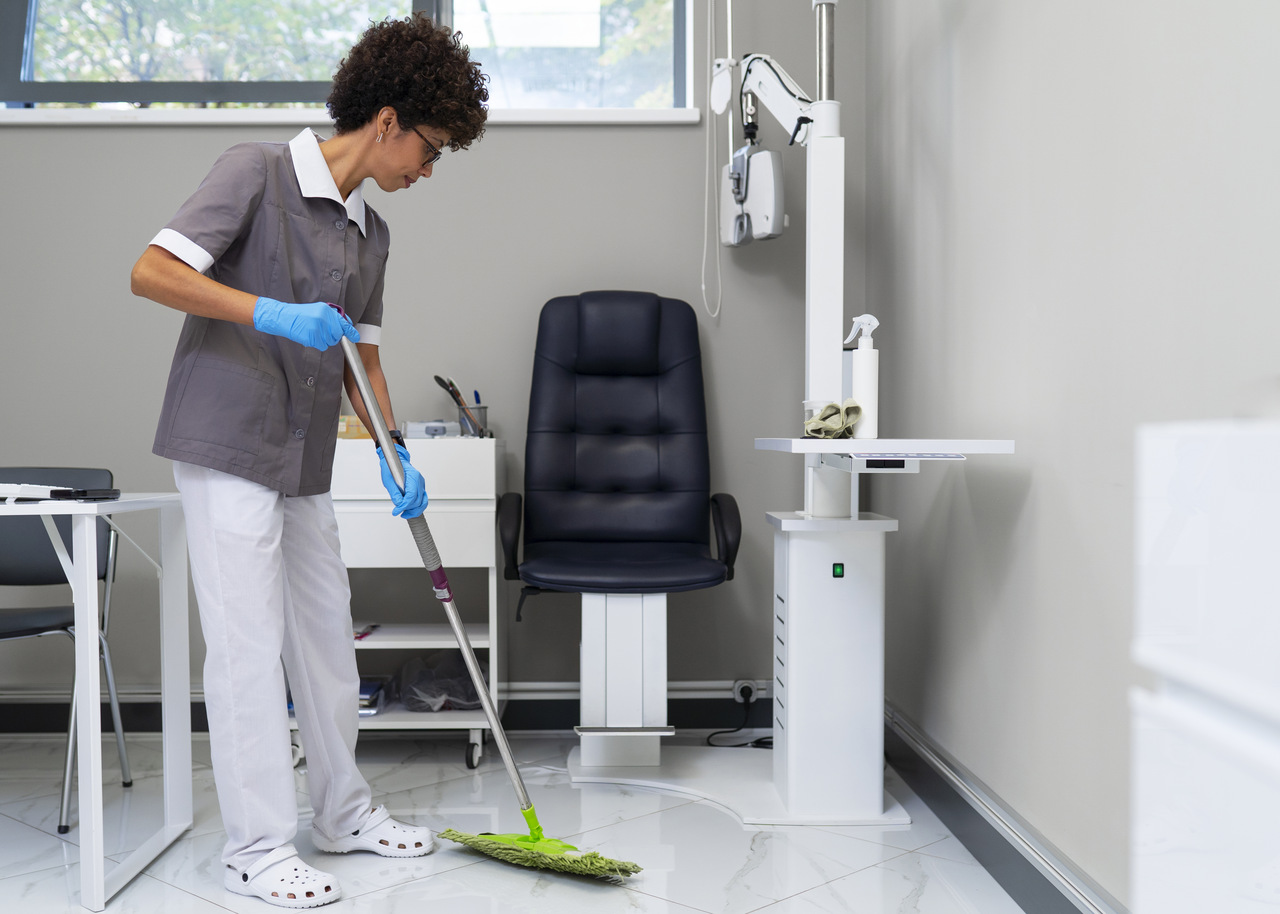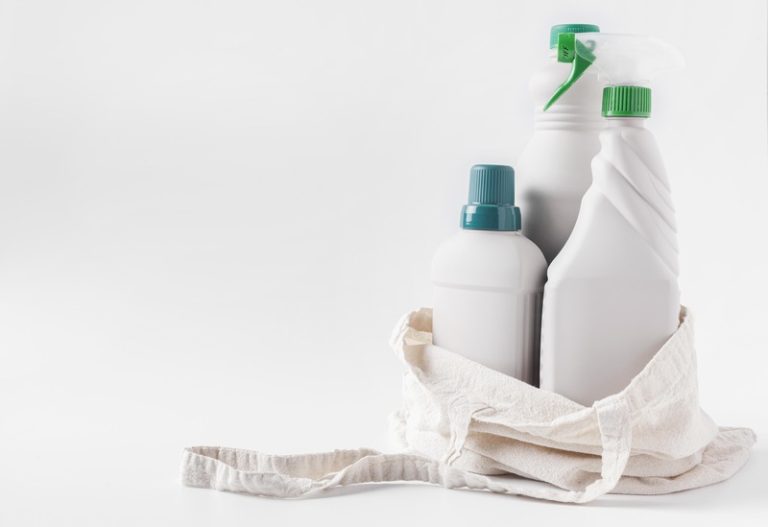Maintaining a clean environment in medical offices is crucial for the health and safety of both patients and staff. Then, how to clean medical offices effectively?
In this article, we explore the importance of medical office cleaning, the risks associated with neglecting hygiene, commonly used cleaning products, and best practices for cleaning various areas in a medical office.
By following the correct cleaning clinics and disinfection protocols, using the right products, and disposing of medical waste properly, we can ensure a safe and hygienic environment for everyone. Read on for more about how to clean a medical office below.
The Importance of Medical Office Cleaning
Before we get into how to clean a doctor’s office further, it’s good to know what the importance of this activity is.
Cleaning medical offices is crucial for maintaining a safe and hygienic environment for patients, staff, and visitors. Proper cleaning practices help to prevent the spread of germs and bacteria, reducing the risk of infections and promoting overall safety within medical facilities.
Professional cleaning services bring expertise and specialised equipment to ensure thorough sanitisation, targeting high-touch surfaces and sensitive areas that require specific attention. By adhering to strict cleaning protocols, these services mitigate the risk of infections and enhance patient safety.
Preventing cross-contamination is paramount in medical settings to safeguard individuals with compromised immune systems. Through diligent cleaning practices and the use of disinfectants, the spread of harmful pathogens is minimised, creating a healthier environment for all.
Maintaining optimal indoor air quality is essential in medical offices to reduce the transmission of airborne illnesses and promote respiratory health. Regular cleaning, ventilation, and air filtration systems help to minimise pollutants and ensure a safe breathing environment for patients and staff.
The Risks of Not Cleaning Medical Offices
The idea of understanding how to clean medical offices is not without reason. Here are some of the risks of neglecting medical office cleaning:
a. Spread of Infections
One of the primary risks associated with not cleaning medical offices is the increased spread of infections among patients and staff.
Without proper disinfection and sterilisation procedures in place, the environment becomes a breeding ground for harmful bacteria and pathogens, heightening the risk of contagious diseases.
Professional cleaning services play a crucial role in preventing the transmission of infections by using specialised equipment and cleaning agents that target and eliminate these disease-causing organisms effectively.
Through regular cleaning routines, including thorough sanitisation practices, the likelihood of infection outbreaks can be significantly reduced, providing a safer and healthier environment for all individuals within the medical facility.
b. Increased Risk of Illness
Failure to maintain proper cleanliness standards in medical offices can lead to an increased risk of illness among patients and staff members.
Inadequate use of detergents and cleaning agents, coupled with ineffective cleaning equipment such as low-powered vacuum cleaners, can result in the persistence of harmful pathogens and allergens. This elevated risk of illness highlights the importance of utilising appropriate cleaning products and equipment to safeguard the health of individuals within the medical facility.
Employing advanced cleaning equipment like high-powered vacuum cleaners plays a crucial role in reducing the presence of pathogens and enhancing overall cleanliness standards. These advanced tools not only improve efficiency but also contribute significantly to creating a healthier environment within medical offices.
c. Decreased Patient Satisfaction
When medical offices are not adequately cleaned, there is a significant impact on patient satisfaction levels. Areas like waiting rooms and toilets, which are commonly frequented by patients, can become sources of discomfort and dissatisfaction if cleanliness is not maintained.
Unclean facilities not only compromise the perceived quality of care but also reflect poorly on the overall professionalism of the healthcare provider, potentially leading to decreased patient satisfaction and trust.
For patients, the cleanliness of a medical facility is a direct reflection of the standards of care they can expect to receive. Hygienic environments are crucial in fostering a sense of trust and confidence in the healthcare system. If patients encounter dirty waiting areas or unsanitary toilets, it can evoke feelings of unease and question the overall hygiene practices of the facility. This negative perception can extend beyond the physical environment, impacting how patients view the competence and attention to detail of the healthcare providers.
Most Commonly Used Cleaning Products in Medical Offices
To fulfil medical office cleaning requirements, there are various cleaning products used to maintain hygiene and cleanliness standards. Some of the most commonly used products include:
a. Disinfectants
Disinfectants are crucial components of medical facility cleaning services as they play a key role in eliminating bacteria and pathogens from surfaces. These cleaning agents are specifically designed to kill harmful microorganisms, ensuring a sanitised environment that reduces the risk of infections and promotes overall health and safety within medical offices.
Effective disinfection is imperative in healthcare settings to prevent the transmission of diseases and ensure patient and staff safety. The use of disinfectants helps in eradicating a wide range of bacteria and viruses, including MRSA, E. coli, and influenza, which can pose serious health risks if not properly addressed.
Regular disinfection routines not only protect against existing pathogens but also create a barrier against potential future contamination, maintaining a clean and hygienic environment essential for the well-being of all individuals entering the medical facility.
b. Detergents
Detergents are essential cleaning agents used in medical clinics to remove dirt, grime, and other particles from surfaces. These cleaning solutions are instrumental in ensuring cleanliness and hygiene standards by effectively lifting and removing contaminants, thereby contributing to a sanitised environment that supports patient and staff well-being.
The primary function of detergents is to break down and emulsify various types of soils, including organic matter, oils, and greases, making it easier to rinse them away. By targeting and encapsulating dirt and grime, detergents help to prevent the spread of harmful pathogens and bacteria, thus reducing the risk of infections in clinical settings. The surfactants in detergents reduce surface tension, allowing water to spread more easily and improve the cleaning process.
c. Bleach
Bleach stands out as one of the most commonly used cleaning products in medical offices due to its unparalleled disinfectant properties and ability to eliminate a wide range of pathogens, including bacteria, viruses, and fungi.
Medical professionals rely on bleach to maintain a clean and hygienic environment, particularly in high-risk areas such as exam rooms, waiting areas, and restrooms. Its effectiveness in killing harmful germs makes it an indispensable tool in infection control protocols, helping to prevent the spread of infectious diseases and protect both patients and healthcare workers.
However, careful handling and dilution are crucial to ensure its safe and effective use, as improper use of bleach can lead to respiratory irritation and damage to surfaces or equipment.
How to Clean Medical Offices in Different Areas?
Cleaning the various areas of a medical office requires a specialised approach that is tailored to the unique cleaning needs of each room. Typically, here are the common approaches that medical facility cleaning services professionals take for each area:
a. Reception Area
The reception area of a medical office is a critical space that requires meticulous cleaning to provide a welcoming and hygienic environment for patients and visitors.
Professional cleaning services play a vital role in maintaining the cleanliness of this area, ensuring that surfaces, furniture, and reception desks are regularly sanitised to promote patient comfort and uphold hygiene standards.
Professional cleaning services typically follow a detailed cleaning protocol tailored to healthcare settings. This includes regular dusting of surfaces, vacuuming carpets, and disinfecting frequently touched areas like door handles and chairs.
Ensuring that the waiting area is clutter-free and well-ventilated also contributes to a comfortable patient experience. Using EPA-approved disinfectants and cleaners helps prevent the spread of germs and infections, supporting a safe and healthy environment for patients and staff alike.
b. Exam Rooms
Cleaning and maintaining hygiene in examination rooms are paramount to prevent cross-contamination and ensure the safety of patients and healthcare providers. Proper disinfection and sterilisation protocols must be followed in these areas to eliminate pathogens and establish a sterile environment conducive to medical examinations and procedures.
Examination rooms in a medical practice require meticulous attention to detail when it comes to cleaning procedures. The high traffic of patients, medical equipment, and varied surfaces necessitates a tailored approach to disinfection and hygiene maintenance.
Implementing thorough disinfection of all high-touch surfaces such as door handles, examination couches, and medical devices is crucial to prevent the spread of harmful bacteria and viruses.
c. Waiting Room
The waiting room in a medical office is a space where patients spend time before appointments, making it essential to prioritise cleanliness and indoor air quality. Maintaining a clean waiting room environment free from allergens and contaminants enhances patient comfort and contributes to a positive healthcare experience.
One of the key aspects of maintaining a clean waiting room is ensuring proper ventilation, which helps in circulating fresh air and reducing the concentration of indoor pollutants. Regular dusting of furniture, vacuuming carpets, and disinfecting surfaces are essential practices to control allergens and germs.
Investing in high-quality air filters for the HVAC system can further improve air quality by trapping dust, pollen, and other particles. A welcoming and hygienic waiting room not only promotes patient well-being but also reflects the professionalism and care of the healthcare facility.
d. Restrooms
Maintaining cleanliness and hygiene in toilets within a medical office is essential to prevent the spread of bacteria and ensure optimal sanitation. Proper disposal of medical waste, regular disinfection of surfaces, and the use of effective cleaning agents are critical in upholding toilet standards that promote infection control and patient safety.
In a medical setting, the risk of bacterial transmission is heightened, underscoring the significance of rigorous cleaning protocols. Adhering to strict waste disposal procedures not only mitigates potential health hazards but also safeguards against cross-contamination.
Thorough disinfection routines targeting high-touch areas like doorknobs and taps are pivotal in curbing microbial proliferation. The judicious selection of disinfectants tailored to combat specific pathogens is key to maintaining a hygienic environment.
Best Practices for Cleaning Medical Offices
Adhering to best practices for cleaning medical offices is vital to maintaining a safe and hygienic environment for patients and healthcare providers. Here is a further explanation of the best practices in how to clean medical offices.
a. Use Proper Personal Protective Equipment (PPE)
Ensuring the use of proper personal protective equipment (PPE) by healthcare providers during cleaning activities is essential for safeguarding against potential exposure to germs and contaminants. PPE, such as gloves, masks, and gowns, plays a crucial role in protecting the health and safety of individuals involved in cleaning medical offices, reducing the risk of infections and promoting a secure working environment.
Properly selected PPE acts as a barrier between healthcare providers and hazardous materials, preventing cross-contamination and maintaining a hygienic workspace. Gloves shield hands from direct contact with chemicals and pathogens, while masks offer respiratory protection against airborne particles.
Gowns protect clothing from contamination during tasks involving potentially infectious materials. By utilising the appropriate PPE, healthcare workers can effectively prevent the transmission of diseases within medical facilities and uphold high standards of cleanliness.
b. Follow Cleaning and Disinfecting Protocols
Adhering to established cleaning and disinfecting protocols is critical in maintaining high hygiene standards and preventing the spread of bacteria within medical offices.
Following specific guidelines for cleaning, disinfection, and sterilisation helps ensure thorough sanitation of surfaces and equipment, reducing the risk of contamination and promoting a safe healthcare environment for patients and staff.
Medical office cleaning protocols play a crucial role in safeguarding against the proliferation of harmful bacteria and viruses. By meticulously following these protocols, healthcare facilities can effectively control the transmission of infectious diseases, ensuring the safety of everyone within the premises.
Proper cleaning procedures involve the removal of dirt and debris from surfaces, which is essential before disinfection can take place.
Disinfection methods, such as using appropriate EPA-approved disinfectants and implementing effective sanitisation techniques, further bolster the defence against microbial threats.
c. Properly Dispose of Medical Waste
Proper disposal of medical waste is essential in maintaining a clean and safe environment within medical offices. Implementing effective waste management practices, including sterilisation and sanitisation of waste disposal areas, helps prevent contamination, reduce environmental impact, and uphold hygiene standards in healthcare facilities.
Ensuring that medical waste is disposed of properly not only contributes to the overall cleanliness and safety of the medical office but also plays a critical role in infection control and environmental safety. By properly managing medical waste, healthcare facilities can minimise the risk of spreading infections and diseases, protecting both patients and staff from potential harm.
The process of sterilisation and sanitisation in waste disposal areas is crucial for maintaining high hygiene standards. Through the use of approved techniques and equipment, such as autoclaves and chemical disinfectants, medical waste can be effectively treated to eliminate harmful pathogens, bacteria, and other contaminants.
This meticulous approach to waste disposal not only ensures a clean healthcare environment but also demonstrates a commitment to environmental responsibility. By following proper waste management protocols, medical offices can reduce their impact on the environment and contribute to sustainable practices in the healthcare industry.
Thus the full explanation of how to clean medical offices. From the above, it can be concluded that ensuring that a medical office is clean and sanitary is crucial not only for the health and safety of patients but also for enhancing the facility’s credibility and trust within the community. A well-maintained medical office reflects the care and attention given to every aspect of patient service, from clinical care to environmental safety.
At TEKA Cleaning, we understand the critical nature of healthcare facility hygiene and offer specialised cleaning services that adhere to the highest standards. Our trained professionals use the latest equipment and techniques, ensuring your medical office remains a safe, sterile, and inviting place for everyone.
Don’t let cleanliness concerns hold your practice back. Book a commercial cleaning service with TEKA Cleaning today or give us a call at 01233 751 544. Let us take care of the cleanliness while you focus on providing excellent healthcare. Trust us to help you maintain a pristine environment that promotes health, safety, and trust among your patients and staff.
Read also:












One response to “How to Clean Medical Offices Properly? A Complete Guide”
I was reading through some of your posts on this site and I believe this
site is very instructive! Continue putting up.Blog monry